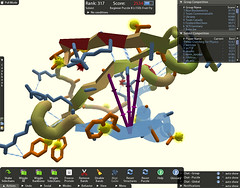A couple of weeks ago I looked at what value levers were
associated with implementing Enterprise
2.0 with the Xbox One and Sony PS4 examples. This week I am looking at benefits
and value levers within the Social sector as outlined by the McKinsey Global Institute (MGI) report, The social economy: Unlocking value and productivity through social technologies.
There are many examples in this field but the one I chose was foldit. The
value lever that I have identified is crowdsource resources and solutions value which is part of the,
collect information and insights, function area.
Crowdsource resources and solutions is to an extent like
harnessing collective intelligence, it promotes participation by the general
populace rather than select or niche groups. For the foldit example it uses the "crowd" to find solutions.
 Foldit is a game where you solve protein puzzles. It
encourages the gamer to predict how the primary structure of a protein “folds”
into a three dimensional structure. According to the foldit website, the two primary
functions of the game are to: predict protein structure and protein design. These functions are needed to understand diseases such as
HIV, Cancer and Alzheimer’s and to design better treatment. The champagne
moment for foldit was when a protein structure of a simian retroviral protein used in animal HIV models but it's three-dimensional model had evaded the
science community for 15 years was solved by foldit players (Hersher, 2012, para. 1).
Foldit is a game where you solve protein puzzles. It
encourages the gamer to predict how the primary structure of a protein “folds”
into a three dimensional structure. According to the foldit website, the two primary
functions of the game are to: predict protein structure and protein design. These functions are needed to understand diseases such as
HIV, Cancer and Alzheimer’s and to design better treatment. The champagne
moment for foldit was when a protein structure of a simian retroviral protein used in animal HIV models but it's three-dimensional model had evaded the
science community for 15 years was solved by foldit players (Hersher, 2012, para. 1).
Basically there are two types of puzzles, the champagne ones like the example above where the community is encouraged to participate in solving unknown protein structures and protein puzzles that are generally well known. The approach that is used by
humans to solve the second type of puzzles is analysed to improve the algorithms of existing
protein-folding software, as there is an argument that the human brain has a
natural three-dimensional pattern matching ability which correlates to humans having better spatial reasoning skills than computers (Moore, 2011, para. 7). Using crowdsourcing to solve puzzles is not new and it
could be argued that the WW2 Enigma code was broken via crowdsourcing. What is
new is the scale that can be achieved via the internet. Instead of having 15,
20 or 50 people working on a problem, there can be thousands or tens of thousands.
While the focus so far has been on enhancing protein-folding
software, foldit will soon incorporate ways to design new proteins that will
ultimately allow users to design and improve drugs to treat different diseases.
In much the same way that the malaria example on the MGI report uses
crowdsourcing for that disease.
With any crowdsourcing example, the more people that are
involved the better the information and insights that are derived.

No comments:
Post a Comment